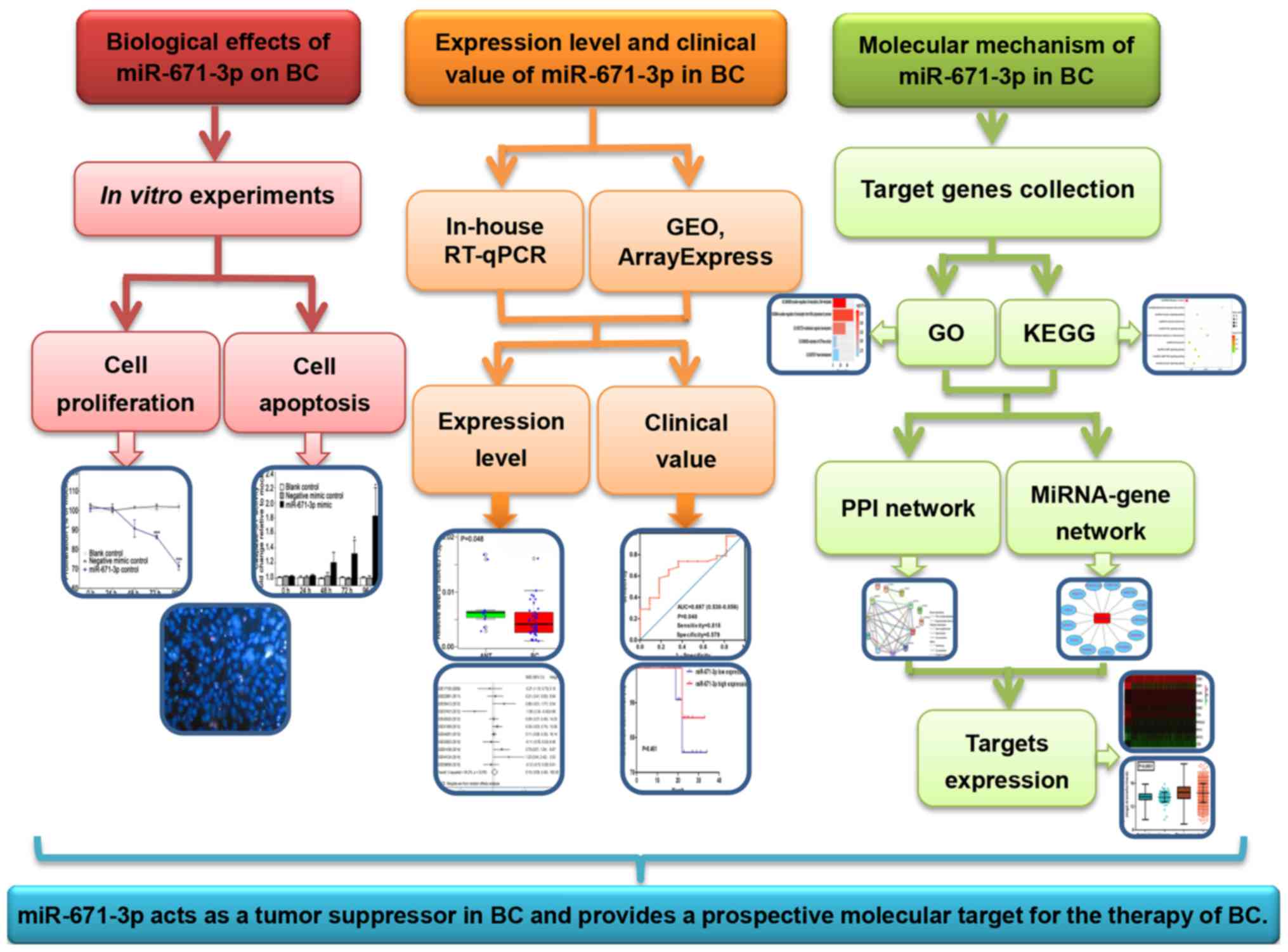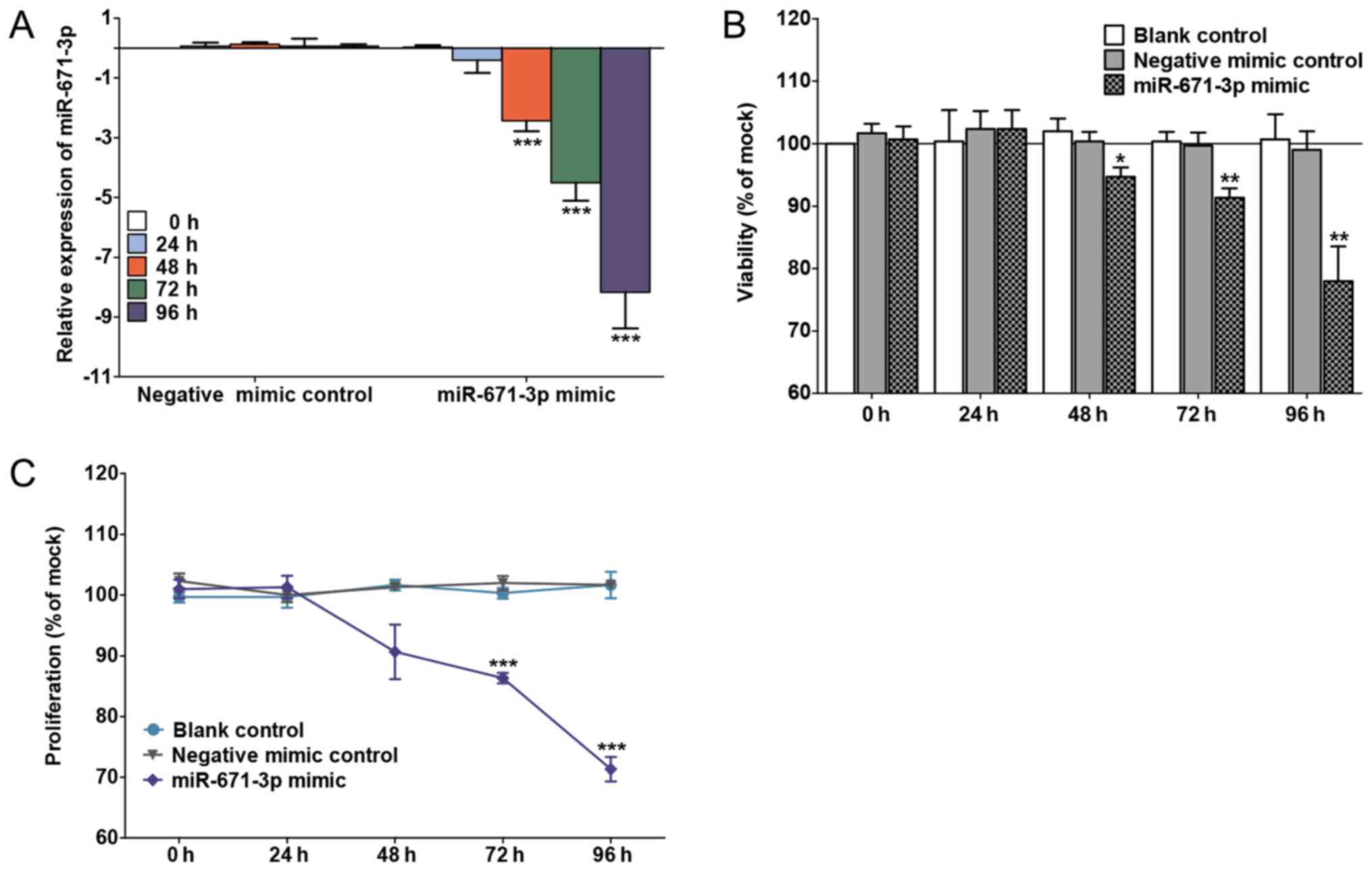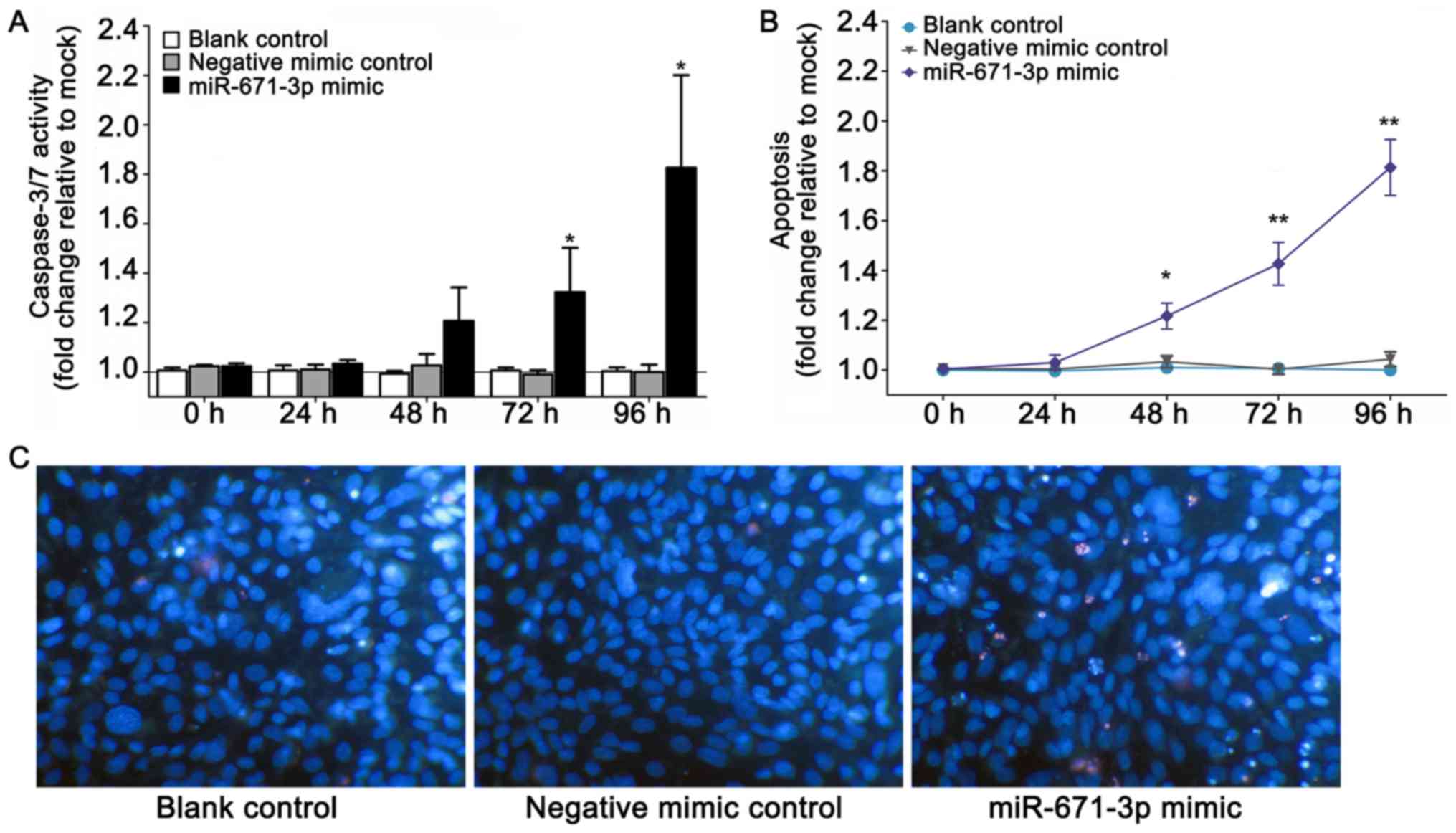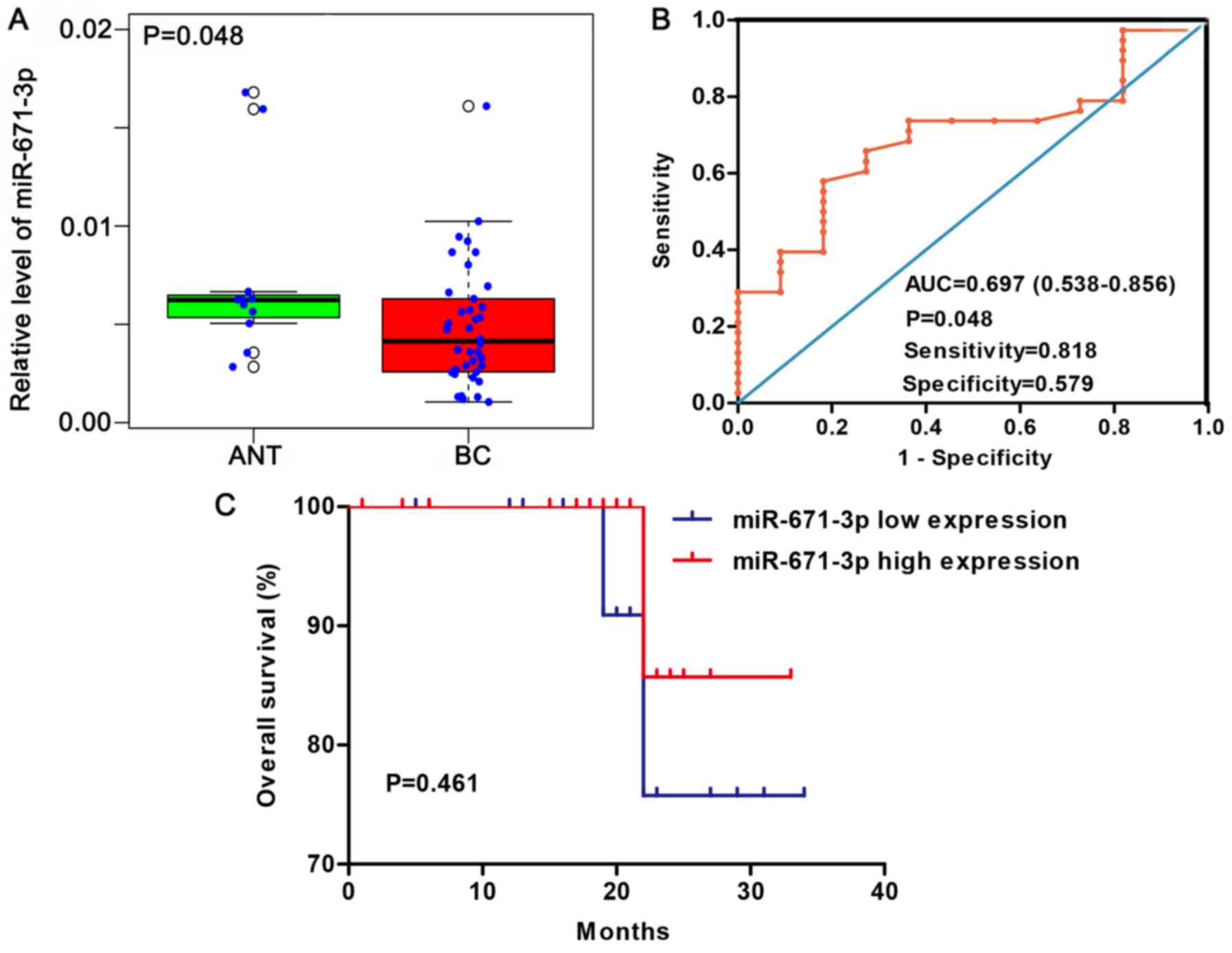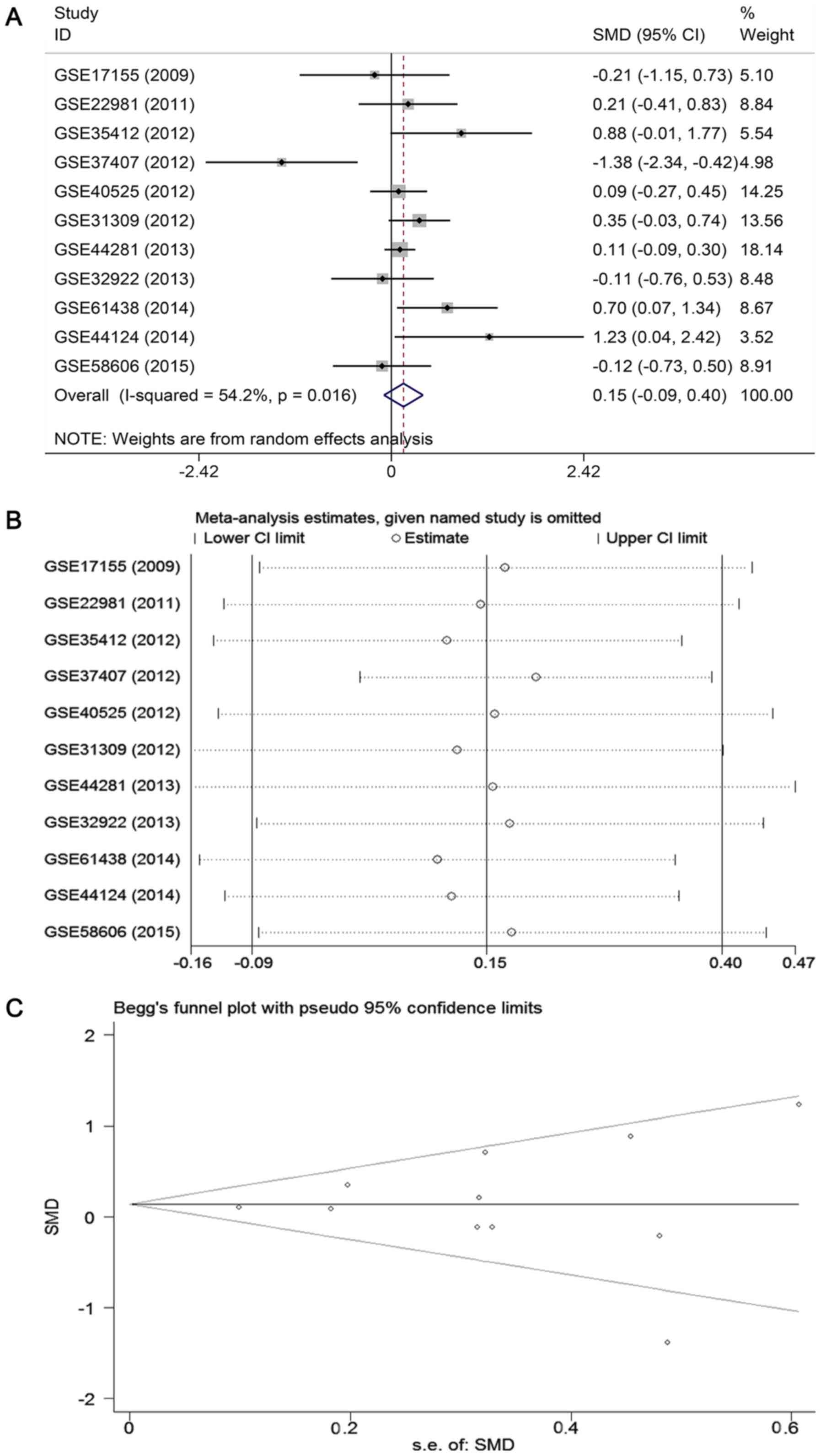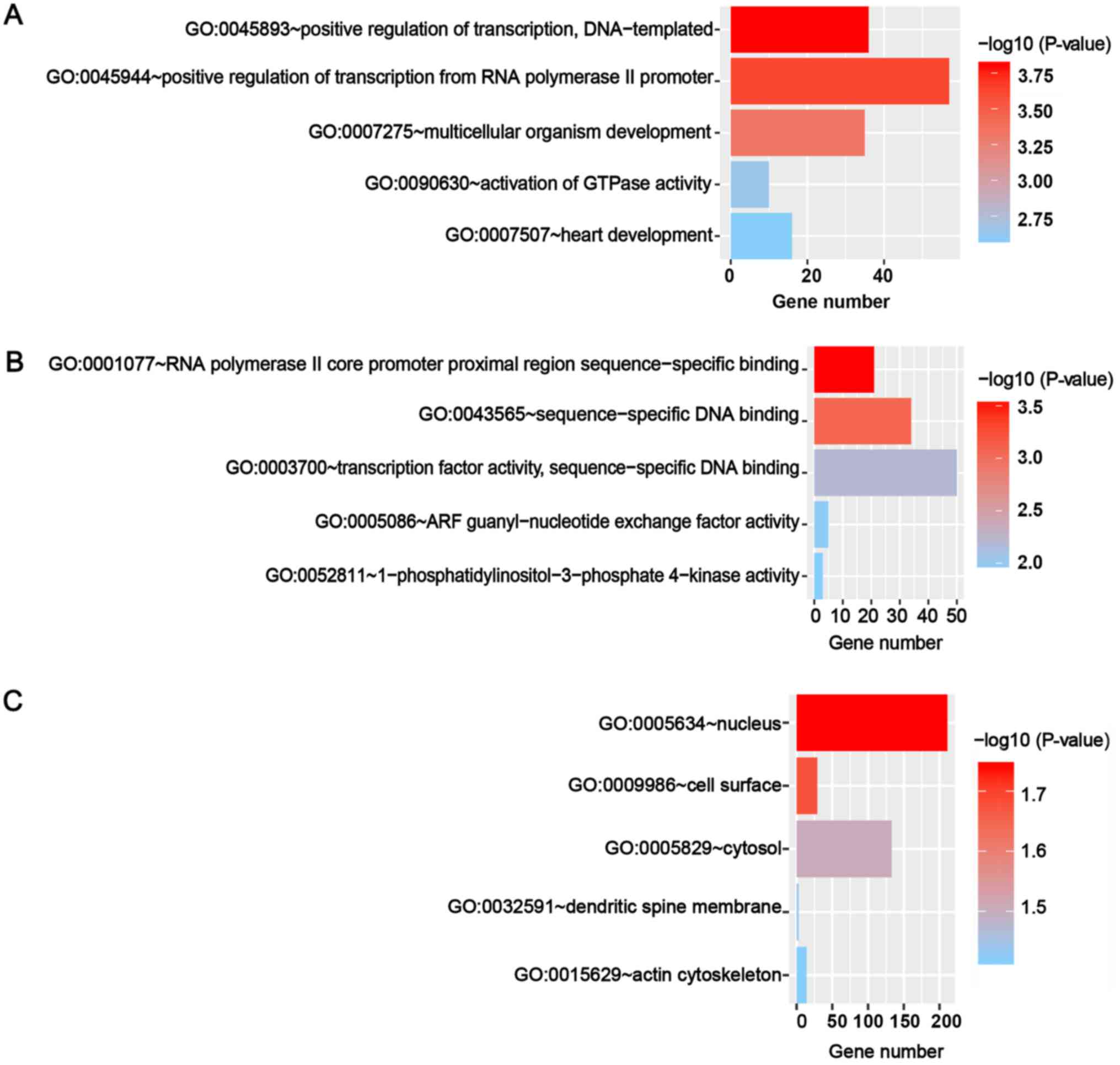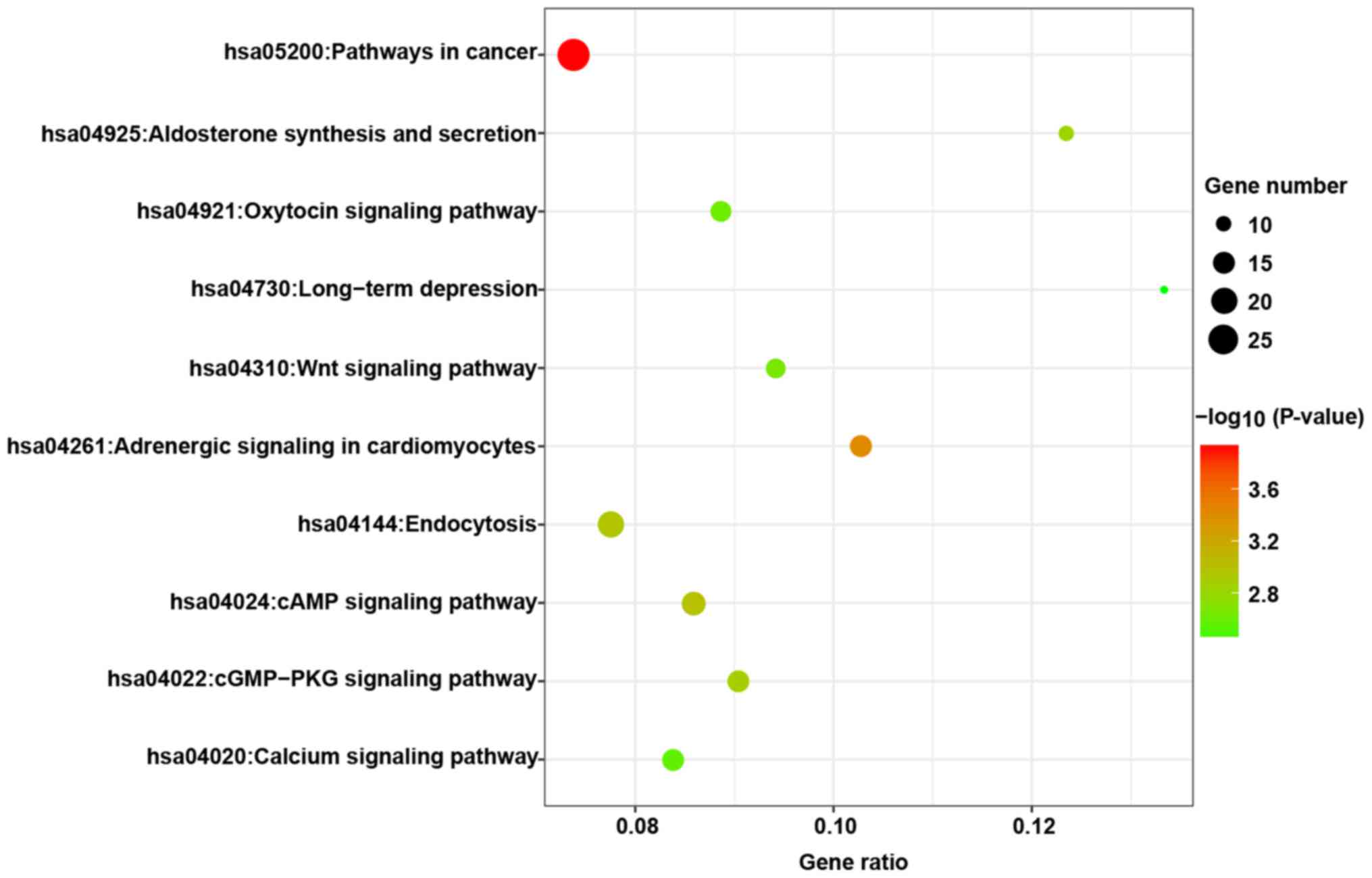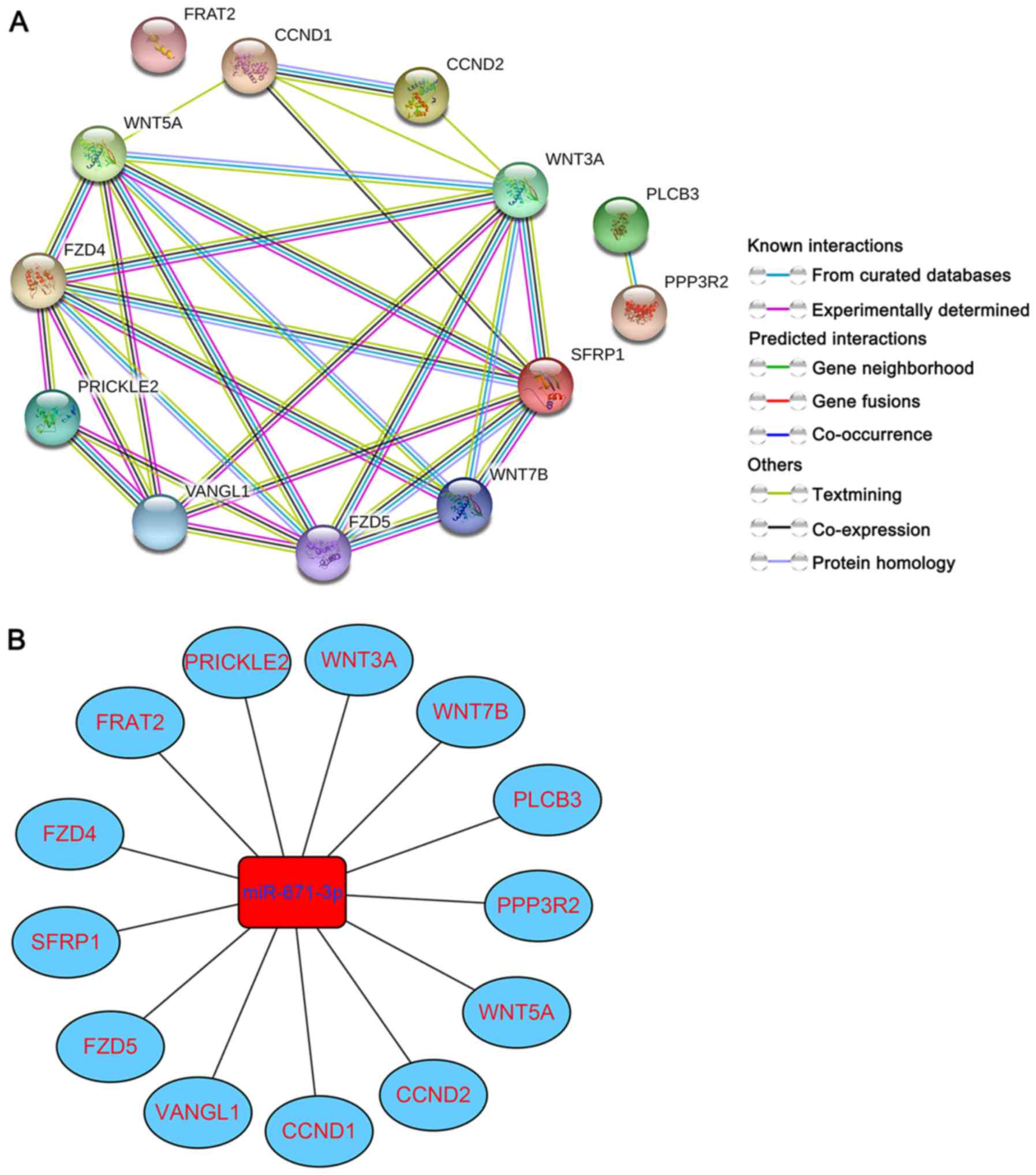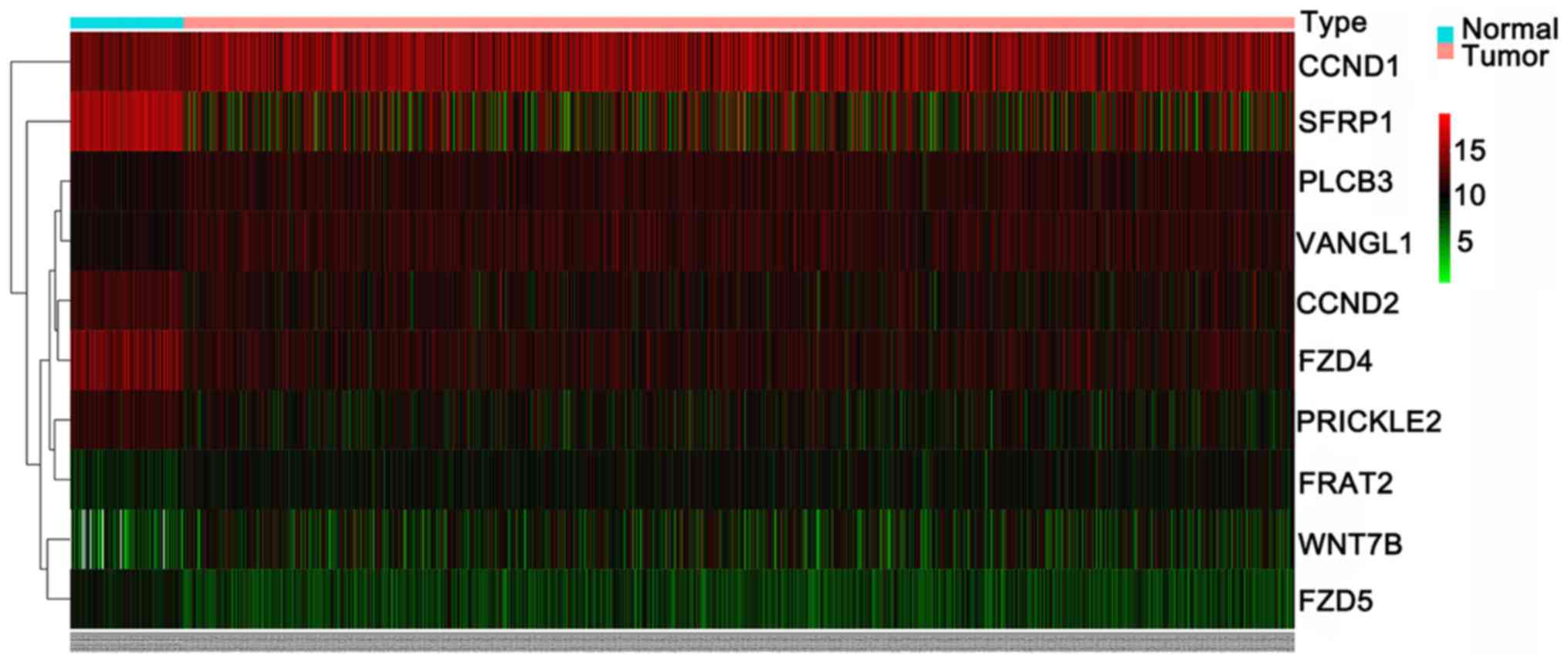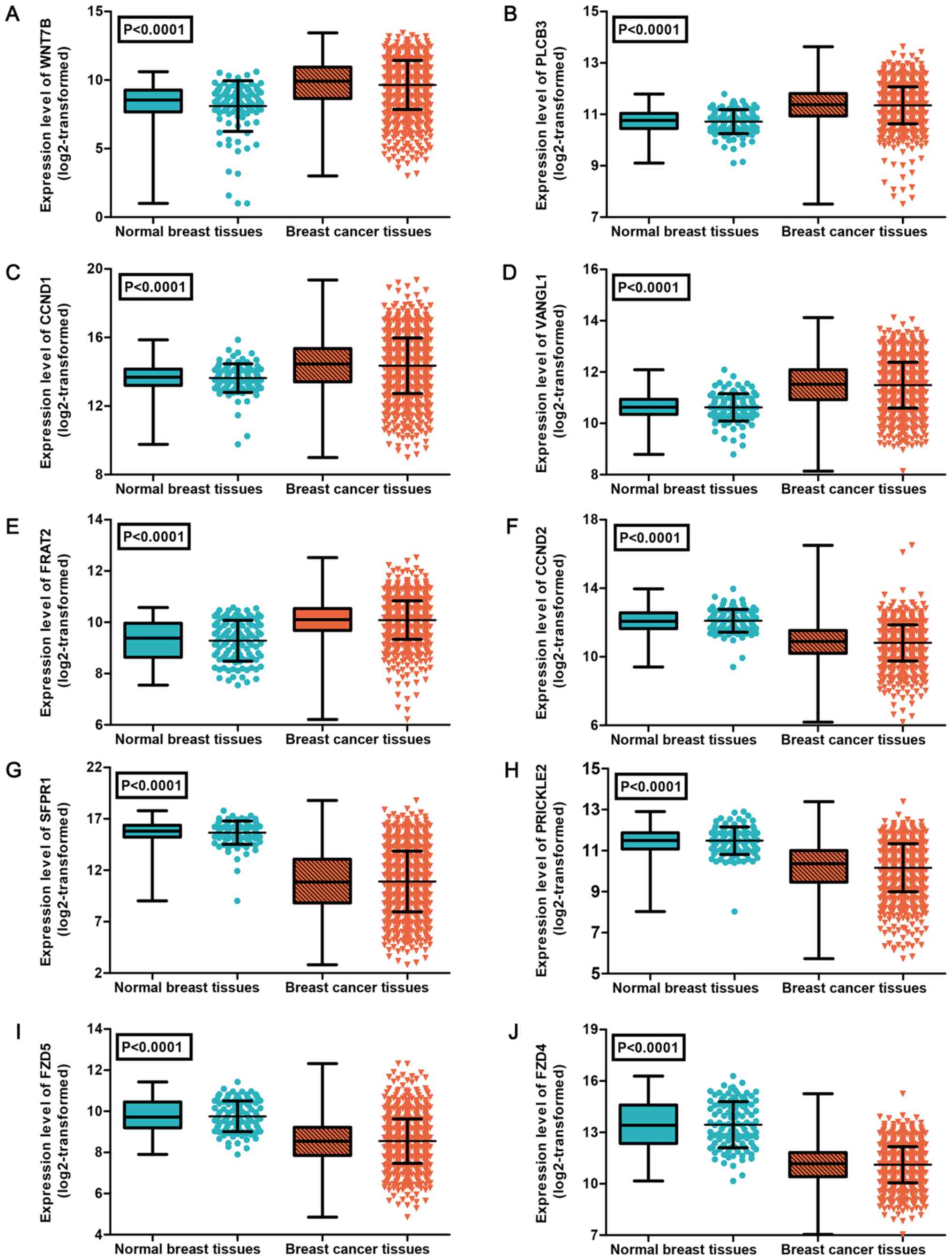MicroRNA-671-3p inhibits the development of breast cancer: A study based on in vitro experiments, in-house quantitative polymerase chain reaction and bioinformatics analysis
- Authors:
- Published online on: March 28, 2018 https://doi.org/10.3892/ijo.2018.4339
- Pages: 1801-1814
-
Copyright: © Xiong et al. This is an open access article distributed under the terms of Creative Commons Attribution License.
Abstract
Introduction
MicroRNAs (miRNAs or miRs) are a major type of small noncoding RNA molecules involved in gene regulation via binding to the 3′ untranslated region of their target mRNAs, and subsequently causing mRNA degradation or translation inhibition (1–4). An increasing volume of research has provided evidence that miRNAs act as oncogenes or tumor suppressors in various malignant tumors by influencing tumor growth, proliferation, apoptosis, invasion and metastasis (5–8). The close association between miRNAs and breast cancer (BC) has also been investigated. For instance, Ding et al (9) revealed that miR-145 is a tumor suppressor in BC and performs its anti-oncogenic role by inhibiting a cancer-associated gene, transforming growth factor-β1. Xiao et al (10) observed that miR-129 blocks BC regeneration by degrading estrogen receptor 1 mRNA at the posttranscriptional level, inhibiting the subsequent estrogen-induced NOTCH cascade and ultimately reducing the number of stem-like cells. A recent study conducted by Lu et al (11) demonstrated that miR-129-5p increases the sensitivity of human epidermal growth factor receptor 2 (Her2)-positive BC to trastuzumab by downregulating ribosomal protein S6. In addition, due to the ease of detecting miRNAs in tumor biopsies and body fluids, numerous researchers have highlighted the diagnostic and prognostic roles of miRNAs in cancer, including in BC. Jang et al (12) examined miR-9 and miR-155 expression levels in triple-negative BC and found that they functioned as biomarkers for prognosis prediction. Zhang et al (13) detected circulating miRNAs expression using a serum-direct multiplex detection assay based on reverse transcription-polymerase chain reaction (RT-PCR). The authors determined a 3-miRNA signature (miR-424, miR-199a and miR-29c) that exhibited the highest diagnostic accuracy for BC diagnosis (13). Our research group has also identified a 9-miRNA signature for BC diagnosis based on data from The Cancer Genome Atlas (TCGA) (14). Therefore, the investigation of miRNAs in cancer has provided promising results, and exploring miRNAs involved in the occurrence and development of BC is conducive to the diagnosis and treatment of patients with BC.
miR-671 precursors form two mature miRNAs, namely miR-671-5p and miR-671-3p. A recent study conducted by Tan et al (15) has demonstrated that miR-671-5p is an antioncogene in BC. The authors also observed that miR-671-5p was downregulated in BC and that forced miR-671-5p expression in the BC cell line MDA-MB-231 was able to inhibit cell proliferation and invasion, and sensitize cells to chemotherapy (15). Furthermore, Godfrey et al (16) compared global miRNA expression in 205 BC patients and 205 healthy volunteers using a microarray method, and observed a high expression of miR-671-3p in the serum samples of BC patients. However, a study concentrating on the biological function and molecular mechanism of miR-671-3p in BC has yet to be reported.
The present study focused on the expression level, biological function and potential molecular mechanism of miR-671-3p in BC. In vitro experiments were conducted to determine the biological effects of miR-671-3p on BC cells, and miR-671-3p expression was detected using RT-quantitative PCR (RT-qPCR). Simultaneously, all available microarray datasets were combined from the Gene Expression Omnibus (GEO) and ArrayExpress databases to verify the expression of miR-671-3p in BC. Furthermore, the predicted targets of miR-671-3p were examined, Gene Ontology (GO) annotation and Kyoto Encyclopedia of Genes and Genomes (KEGG) pathway analyses were conducted, and a protein-protein interaction (PPI) network was constructed to gain insight into the underlying molecular mechanism of miR-671-3p in BC.
Materials and methods
Patients and samples
A total of 38 pairs of BC and adjacent non-tumorous tissues were obtained from patients who were pathologically diagnosed with BC (17). To ensure that the RT-qPCR results were not affected by the size of paraffin-embedded tissues, samples with a surface area that was too small or large were excluded. Finally, 38 BC tissues and 11 adjacent non-tumorous tissues with a surface area of ~1.5 cm2 were selected. All patients underwent initial surgery at the First Affiliated Hospital of Guangxi Medical University (Nanning, China) between January 2012 and December 2013, and had not received any preoperative radiotherapy or chemotherapy. Adjacent non-tumorous tissues were collected at >5 cm away from the tumorous node. Following excision, tissues were cryopreserved in liquid nitrogen and stored at −80°C prior to RNA extraction. All participants provided informed consent prior to sample collection. The Ethics Committee of the First Affiliated Hospital of Guangxi Medical University approved this investigation. The workflow of the present study is exhibited in Fig. 1.
Cell culture and transfection with miR-671-3p mimic
The human BC-derived cell line MDA-MB-231 was provided by the American Type Culture Collection (Manassas, VA, USA) and cultured as described in previous studies (18,19). For transfection, MDA-MB-231 cells were seeded in a 96-well plate (2.5×103 cells per well), and subsequently incubated at 37°C for 24 h. Next, miR-671-3p mimic and negative mimic control (Ambion; Thermo Fisher Scientific, Inc., Waltham, MA, USA) were transfected into the cells at a concentration of 200 nmol/l with a CombiMag Magnetofection transfection kit (OZ Biosciences, Marseille, France) according to the manufacturer's protocol. A blank control was set with nothing transfected into cells. Following transfection, cell samples were collected at 0, 24, 48, 72 and 96 h for further analyses. All in vitro experiments were conducted in triplicate.
RT-qPCR
Total RNA was isolated using the miRNeasy FFPE kit (Qiagen, Duesseldorf, German) following the manufacturer's protocol. The measurement of total RNA quality was conducted on NanoDrop-2000 Ultra Micro Spectrophotometer (Thermo Fisher Scientific, Inc.), and an RNA concentration >45 ng/µl was required based on the calculation by the instructions of miScript II RT kit and miScript SYBR-Green PCR kit. Then, total RNA was reversed into cDNA with miScript II RT kit (Qiagen). Subsequently, RT-qPCR was conducted with 7900HT Fast Real-Time PCR System (Applied Biosystems; Thermo Fisher Scientific, Inc.) in accordance with the manufacturer's protocol. The thermal cycling conditions are shown in Table I. RNU44 was used as a reference gene for the normalization of miR-671-3p abundance. The primers for miR-671-3p (cat. no. 1000066; CCGGUUCUCAGGGCUCCACC) and RNU44 (cat. no. MS00033855) were synthesized by Qiagen. All the samples were examined in triplicate, and the mean of the three well values were used as the Cq value. The relative expression level of miR-671-3p was determined according to the 2−ΔCq method (ΔCq = CqmiR-671-3p-CqRNU44), as previously described (20,21).
Cell function detection
Cell viability and proliferation were examined by fluorometric detection with resorufin (CellTiter-Blue Cell Viability Assay; cat. no. G8080; Promega Corportation, Madison, WI, USA) and a colorimetric tetrazolium (MTS) assay (CellTiter96 AQUEOUS One Solution Cell Proliferation Assay; cat. no. G3580; Promega Corporation), respectively. Furthermore, cell apoptosis was assessed by Hoechst 33342 and propidium iodide (PI; both purchased from Sigma-Aldrich; Merck KGaA, Darmstadt, Germany) double-fluorescent chromatin staining. Caspase-3/7 activity was also examined with a synthetic rhodamine-labeled caspase-3/7 substrate (Apo-ONE Homogeneous Caspase-3/7 Assay; cat. no. G7790; Promega Corporation). The protocols of these assays were performed as reported in previous studies (18,19,21–23).
Studies on GEO and ArrayExpress databases
To verify the expression level of miR-671-3p in BC, a meta-analysis was conducted based on data obtained from the GEO (www.ncbi.nlm.nih.gov/geo) and ArrayExpress (www.ebi.ac.uk/array-express) databases. Relevant records were retrieved with the following keywords: (cancer OR carcinoma OR tumor OR neoplas* OR malignan*) AND (breast OR mammary OR mastocarcinoma) AND (miRNA OR microRNA OR miR OR 'non-coding RNA' OR ncRNA). The last update time was October 25th, 2017. Datasets were included once they met the following inclusion criteria: i) The records provided expression data of miR-671-3p in BC; ii) the number of samples in each dataset in the cancerous and non-tumorous groups was >3; and iii) the subjects involved in the study were humans. The following datasets were excluded: i) Studies not associated with BC; ii) records with insufficient data to calculate the expression level of miR-671-3p; and iii) animal studies.
Two trained investigators independently screened all available datasets and extracted the following characteristics from all the enrolled studies: First author, publication year, country, data source, platform, sample size, and expression values of miR-671-3p in cancer and normal groups. Any disagreement was resolved through discussion with a third researcher.
The standard mean difference (SMD) with the 95% confi-dence interval (CI) was calculated to appraise miR-671-3p expression in BC. SMD <0 indicated that miR-671-3p was downregulated, and the result was consider as statistically significant if the corresponding 95% CI of SMD did not overlap zero. Heterogeneity among studies was evaluated by the χ2-based Q test and I2 statistic. If a statistically significant heterogeneity existed (I2 >50% or P<0.05), a random-effects model was applied. Otherwise, a fixed-effects model was selected (24). Furthermore, sensitivity analysis was conducted to evaluate whether the pooled result was stable. Begg's funnel plot and Egger's test were also used to determine the possible publication bias, with P>0.05 suggesting no publication bias. All the aforementioned calculations were performed with Stata software, version 12.0 (Stata Corporation, College Station, TX, USA).
Target prediction and bioinformatics analyses
The predicted target genes of miR-671-3p were determined using the miRWalk 2.0 database (zmf.umm.uni-heidelberg.de/apps/zmf/mirwalk2), which contains 12 online tools, namely Targetscan, RNAhybrid, RNA22, PITA, Pictar2, miRWalk, Microt4, miRNAMap, miRDB, mirbridge, miRanda and miRMap. Targets predicted by >3 algorithms were selected for GO functional annotation and KEGG pathway analyses using the DAVID online tool (david.ncifcrf.gov). Subsequently, the enriched results were visualized with the R package 'ggplot2' (cran.r-project.org/web/packages/ggplot2/index.html). To better understand the molecular mechanism of miR-671-3p in BC, target genes enriched in cancer-associated pathways were uploaded to the STRING database (string-db.org) for PPI network construction. Meanwhile, the regulatory network of the miRNA-gene was constructed and visualized with Cytoscape version 3.4.0 software (25). Furthermore, the expression of these target mRNAs was validated using data from TCGA (cancergenome.nih.gov). A heatmap was drawn with the R package 'pheatmap' (cran.r-project.org/web/packages/pheatmap/index.html), and a box-scatter plot was generated with GraphPad Prism 5 software (GraphPad Software, Inc., La Jolla, CA, USA).
Statistical analysis
Values are represented as the mean ± standard deviation. Mann-Whitney U test and Student's t-test were applied for comparison between continuous variables. Fisher's exact test was also conducted to evaluate the correlation between miR-671-3p expression and clinicopathological parameters of age, histological grade (26), T stage, N stage, M stage, TNM stage (27), molecular subtype, ER/PR status and Her2 status. A receiver operating characteristic (ROC) curve was generated to determine the ability of miR-671-3p to distinguish BC from non-tumorous breast tissues. A Kaplan-Meier survival curve with log-rank test was utilized to estimate the prognostic power of miR-671-3p in BC. All these analyses were conducted using SPSS version 22.0 software (IBM Corp., Armonk, NY, USA), and P<0.05 was considered to indicate a difference that was statistical significance.
Results
miR-671-3p mimic arrests the proliferation and induces the apoptosis of BC cells in vitro
The transfection efficiency is shown in Fig. 2A. miR-671-3p was significantly upregulated in the miR-671-3p mimic group at 48 h (P<0.0001), 72 h (P<0.0001) and 96 h (P<0.0001) compared with the negative mimic control group. An unregulated miR-671-3p decreased cell viability and proliferation, as determined by the fluoro-metric resorufin and MTS assays, respectively (Fig. 2B and C). Furthermore, to explore the effects of the miR-671-3p mimic on cell apoptosis, CellTiter-Blue and fluorescent caspase-3/7 assays were conducted. The results indicated that the caspase-3/7 activity and apoptosis of cells transfected with miR-671-3p mimic increased compared the caspase-3/7 activity and apoptosis of cells in the blank and negative mimic control groups (Fig. 3A and B). In addition, viable and apoptotic cells were observed under a microscope subsequent to Hoechst 33342/PI double-fluorescent chromatin staining at 96 h. The results revealed that miR-671-3p overexpression evidently inhibited the viability and boosted the apoptosis of MDA-MB-231 cells in vitro (Fig. 3C).
Expression level and clinical value of miR-671-3p in BC via in-house RT-qPCR
According to the median expression of miR-671-3p in 38 BC tissues and 11 adjacent non-tumorous tissues, samples were divided into high- and low-miR-671-3p group. A total of 17 tumor samples (44.7%) exhibited high miR-671-3p expression, while 9 non-tumorous samples (81.8%) presented high miR-671-3p expression (81.8%). The expression pattern of miR-671-3p was visualized as a box-scatter plot and ROC curve. According to the results, the miR-671-3p expression was significantly lower in cancer tissues when compared with that in adjacent non-tumorous tissues (P=0.048; Fig. 4A). The area under the ROC curve was 0.697 (95% CI=0.538-0.856; P=0.048; Fig. 4B), with a sensitivity and specificity of 0.818 and 0.579, respectively.
The association of miR-671-3p expression with the clinicopathological characteristics of patients, including the age, histological grade, T stage, N stage, M stage, TNM stage, molecular subtype, ER/PR status and Her2 status, was investigated. As shown in Table II, no statistically significant differences were detected. Furthermore, the association between miR-671-3p expression and prognosis was examined. The patients were divided into high and low miR-671-3p expression groups according to the median value of miR-671-3p expression. Patients with highly expressed miR-671-3p had a mean survival time of 31.429 months, while patients with low miR-671-3p expression had a mean survival time of 30.818 months. However, no statistically significant difference was observed between the two groups (P=0.461; Fig. 4C).
Table IIAssociation between miR-671-3p expression and clinicopathological parameters of patients (n=38). |
Results of meta-analyses based on GEO and ArrayExpress databases
To further verify the expression level of miR-671-3p in BC, a meta-analysis based on microarray datasets was conducted. A total of 11 studies with 688 BC patients and 400 healthy subjects were included (16,28-36). The basic characteristics of the 11 available datasets are displayed in Table III. The combined SMD from a random-effects model demonstrated that the expression of miR-671-3p in BC samples was similar to that in normal controls (SMD: 0.15, 95% CI: -0.09 to 0.40, P=0.222; heterogeneity: I2=54.2%, P=0.016; Fig. 5A). Sensitivity analysis revealed that the pooled result was stable (Fig. 5B). Begg's and Egger's tests indicated that no publication bias was observed among the 11 records (Begg's test, P=0.755; Egger's test, P=0.564; Fig. 5C).
Table IIIMain characteristics of the 11 included microarray datasets obtained from the GEO and ArrayExpress databases. |
Prospective molecular mechanism of miR-671-3p in BC, as determined by enrichment analyses
The putative targets of miR-671-3p were predicted in 12 online prediction databases (Targetscan, RNAhybrid, RNA22, PITA, Pictar2, miRWalk, Microt4, miRNAMap, miRDB, mirbridge, miRanda and miRMap), and targets confirmed by >3 algorithms were selected for further analyses. A total of 1,470 targets combined were obtained by GO and KEGG analyses. The GO analyses included three categories, namely biological process, molecular function and cellular component. The top five GO annotations are shown in Fig. 6, and the results suggested that the targets of miR-671-3p were markedly enriched in the cell nucleus and participated in transcription regulation. The top 10 KEGG pathways are presented in Fig. 7, and it was observed that these predicted targets may be involved in several tumor-associated pathways, including pathways in cancer and the Wnt signaling pathway.
Construction of PPI network and miRNA-gene regulatory network
To further delve into the potential molecular mechanism of miR-671-3p in BC, targets enriched in the Wnt signaling pathway were selected for PPI network construction. The following 13 genes were selected: WNT5A, WNT7B, WNT3A, PLCB3, CCND1, CCND2, VANGL1, SFRP1, PRICKLE2, PPP3R2, FRAT2, FZD5 and FZD4. As shown in Fig. 8A, a total of 13 nodes and 29 edges were involved in the PPI network. Simultaneously, the miRNA-gene regulatory network was formed based on the 13 miRNA-gene pairs (Fig. 8B).
Subsequently, the expression levels of the 13 genes were verified using data from TCGA. Due to the expression of genes WNT3A and PPP3R2 being zero in >10% of samples, those genes were removed from the expression analysis (37). As shown in Table IV, the results identified 10 differently expressed target genes in BC, including 5 upregulated genes (WNT7B, PLCB3, CCND1, VANGL1 and FRAT2) and 5 downregulated genes (CCND2, SFRP1, PRICKLE2, FZD5 and FZD4). The expression patterns of the 10 differently expressed genes were visualized as a heatmap (Fig. 9) and box-scatter plots (Fig. 10).
Discussion
BC is an aggressive cancer that threatens the health of women. It is the most prevalent tumor and the main cause of oncogenic mortality in women worldwide, with an estimated 1,676,600 newly diagnosed cases and 521,900 associated mortalities annually (38). Although specific molecular biomarkers for optimizing clinical management have been explored (39–41), their clinical application remains limited due to the heterogeneity and complexity of BC. Therefore, probing effective biomarkers to better understand the molecular mechanism of BC and to provide appropriate target treatments for BC patients is essential. The aim of the present study was to address the expression level, clinical value, biological function and molecular mechanism of miR-671-3p in BC and, further, to explore the potential clinical usability of miR-671-3p for therapeutic decisions in BC.
In the present study, in vitro experiments were conducted to examine the biological effects of miR-671-3p on the proliferation and apoptosis of BC cells by transfecting a miR-671-3p mimic into MDA-MB-231 cells. The results revealed that the miR-671-3p mimic evidently attenuated cell proliferation and induced cell apoptosis, indicating that miR-671-3p was a tumor suppressor in BC.
Only one previous study conducted by Godfrey et al (16) has reported the expression pattern of miR-671-3p in BC. The authors detected miRNA expression in serum of BC patients and healthy participants using array Affymetrix arrays and demonstrated that 16 miRNAs, including miR-671-3p, were overexpressed in the serum of BC patients. The authors validated the expression levels of the three miRNAs with the highest expression using RT-qPCR; however, no statistically significant differences were detected. Given the low accuracy of gene chip technology, large-scale studies based on RT-qPCR are imperative for verifying the serum level of miR-671-3p in BC patients. In the present study, miR-671-3p expression was examined in BC and non-tumorous tissues using RT-qPCR, and the results indicated that miR-671-3p was downregulated in cancer tissues. All available relevant microarray datasets were also collected in order to further confirm the expression level of miR-671-3p in BC. However, the result revealed that the expression of miR-671-3p in BC tissues was similar to that in the normal controls, which was not consistent with the results of RT-qPCR. Differences in sample sources and detection methods may explain this inconsistency in the findings. For instance, the expression of miR-671-3p may vary across individuals. In addition, the accuracy of RT-qPCR is higher compared with that of microarray analysis. Although a total of 11 microarray datasets were included to assess the expression level of miR-671-3p in BC and the pooled result was stable, the results should be interpreted with caution, since these datasets were obtained from different platforms, resulting in a significant heterogeneity in the current study. Additionally, the confounders induced by different RNA extraction methods and diverse RNA detection platforms may also limit the validity of the present meta-analysis results. Thus, further and larger-scale RT-qPCR-based investigations will be indispensable in deciphering the exact expression of miR-671-3p in BC.
The association of miR-671-3p expression with the clinicopathological parameters and overall survival of patients was also analyzed to determine whether miR-671-3p can function as a predictive indicator in BC. However, no association between miR-671-3p expression and the clinicopathological factors was detected. Patients with high miR-671-3p expression survived longer in comparison with patients with low miR-671-3p expression, however, no statistically significant difference was observed. Considering the relatively small sample size of 38 cases in the present study, further investigation including more samples is required to determine the prognostic value of miR-671-3p in patients with BC.
Finally, the in silico GO and KEGG analyses in the present study revealed the potential molecular mechanism of miR-6713p in the tumorigenesis of BC. It was observed that the predicted targets of miR-671-3p were involved in several tumor-associated pathways, including the Wnt signaling pathway. The Wnt signaling pathway is known to be closely linked with the initiation and progression of various malignant tumors, including BC, by driving of the epithelial-mesenchymal transition and metastasis of tumor cells (42-47). Accumulating evidence has suggested that the Wnt signaling cascade is regulated by miRNAs (46,48-51). A study performed by Cai et al (46) indicated that miR-374a activates the Wnt signaling pathway in BC by inhibiting negative modulators of the Wnt signaling cascade, including WNT5A, WIF1 and PTEN. A study conducted by Yi et al (51) demonstrated that miR-214 negatively regulates the Wnt signaling cascade and, consequently, inhibits cell proliferation in BC. However, the regulatory effects of miR-671-3p on the Wnt signaling pathway have yet to be determined. In the current study, it was observed that 13 target genes (WNT5A, WNT7B, WNT3A, PLCB3, CCND1, CCND2, VANGL1, SFRP1, PRICKLE2, PPP3R2, FRAT2, FZD5 and FZD4) of miR-671-3p were significantly enriched in the Wnt signaling pathway. To further determine the roles of the 13 genes in BC, their expression patterns were investigated using data from TCGA. The results revealed that the genes WNT7B, PLCB3, CCND1, VANGL1 and FRAT2 were evidently upregulated in BC, indicating that they may act as oncogenes, while WNT3A, CCND2, SFRP1, PRICKLE2, FZD5 and FZD4 were markedly downregulated in BC, suggesting that they may function as tumor suppressor genes in this tumor. Furthermore, it is inferred that miR-671-3p may suppress the tumorigenesis and development of BC by interacting with these genes, and further inhibiting the Wnt signaling pathway. However, further rigorous investigation is requited to confirm the targeting effects of miR-671-3p on these genes.
In conclusion, the present study provided evidence that miR-671-3p functions as a tumor suppressor to inhibit the initiation and development of BC by influencing the Wnt signaling pathway, as observed by in vitro experiments, in-house RT-qPCR, microarray datasets and bioinformatics analyses. The findings also demonstrated a possible molecular mechanism of miR-671-3p in BC, indicating that miR-671-3p may be a prospective molecular target for the therapy of BC. Further investigation is required to verify these conclusions.
Acknowledgments
Not applicable.
Funding
This study was supported by grants from the Natural Science Foundation of Guangxi, China (grant nos. 2017GXNSFAA198067 and 2015GXNSFAA139187).
Availability of data and materials
The datasets used and/or analyzed during the current study are available from the corresponding author on reasonable request.
Authors' contributions
DDX collected and analyzed the data from the GEO and Oncomine databases, participated in the statistical analyses and was a major contributor in the writing of the manuscript. HC performed in-house RT-qPCR and in vitro experiments. RQH, AHL and JCZ conducted the bioinformatics analyses. GC examined all of the data presented in the manuscript. ZBF and KLW guided the design of all of the experiments and the writing of the manuscript. All authors have read and approved the final manuscript.
Ethics approval and consent to participate
All participants provided informed consent prior to sample collection. The Ethical Committee of the First Affiliated Hospital of Guangxi Medical University approved this investigation.
Consent for publication
Not applicable.
Competing interests
The authors declare that they have no competing interests.
References
|
Bartel DP: MicroRNAs: Genomics, biogenesis, mechanism, and function. Cell. 116:281–297. 2004. View Article : Google Scholar : PubMed/NCBI | |
|
Sayed D and Abdellatif M: MicroRNAs in development and disease. Physiol Rev. 91:827–887. 2011. View Article : Google Scholar : PubMed/NCBI | |
|
Fan FY, Deng R, Yi H, Sun HP, Zeng Y, He GC and Su Y: The inhibitory effect of MEG3/miR-214/AIFM2 axis on the growth of T-cell lymphoblastic lymphoma. Int J Oncol. 51:316–326. 2017. View Article : Google Scholar : PubMed/NCBI | |
|
Yu M, Xue H, Wang Y, Shen Q, Jiang Q, Zhang X, Li K, Jia M, Jia J, Xu J, et al: miR-345 inhibits tumor metastasis and EMT by targeting IRF1-mediated mTOR/STAT3/AKT pathway in hepatocellular carcinoma. Int J Oncol. 50:975–983. 2017. View Article : Google Scholar : PubMed/NCBI | |
|
He R, Yang L, Lin X, Chen X, Lin X, Wei F, Liang X, Luo Y, Wu Y, Gan T, et al: MiR-30a-5p suppresses cell growth and enhances apoptosis of hepatocellular carcinoma cells via targeting AEG-1. Int J Clin Exp Pathol. 8:15632–15641. 2015. | |
|
Xie Z, Chen W, Chen Y, Wang X, Gao W and Liu Y: miR-768-3p is involved in the proliferation, invasion and migration of non-small cell lung carcinomas. Int J Oncol. 51:1574–1582. 2017. View Article : Google Scholar | |
|
Shang A, Yang M, Shen F, Wang J, Wei J, Wang W, Lu W and Wang C and Wang C: MiR-1-3p suppresses the proliferation, invasion and migration of bladder cancer cells by up-regulating SFRP1 expression. Cell Physiol Biochem. 41:1179–1188. 2017. View Article : Google Scholar : PubMed/NCBI | |
|
Chen G, He M, Yin Y, Yan T, Cheng W, Huang Z, Zhang L, Zhang H, Liu P, Zhu W, et al: miR-1296-5p decreases ERBB2 expression to inhibit the cell proliferation in ERBB2-positive breast cancer. Cancer Cell Int. 17:952017. View Article : Google Scholar : PubMed/NCBI | |
|
Ding Y, Zhang C, Zhang J, Zhang N, Li T, Fang J, Zhang Y, Zuo F, Tao Z, Tang S, et al: miR-145 inhibits proliferation and migration of breast cancer cells by directly or indirectly regulating TGF-β1 expression. Int J Oncol. 50:1701–1710. 2017. View Article : Google Scholar : PubMed/NCBI | |
|
Xiao G, Li X, Li G, Zhang B, Xu C, Qin S, Du N, Wang J, Tang SC, Zhang J, et al: MiR-129 blocks estrogen induction of NOTCH signaling activity in breast cancer stem-like cells. Oncotarget. 8:103261–103273. 2017. View Article : Google Scholar : PubMed/NCBI | |
|
Lu X, Ma J, Chu J, Shao Q, Zhang Y, Lu G, Li J, Huang X, Li W, Li Y, et al: MiR-129-5p sensitizes the response of Her-2 positive breast cancer to trastuzumab by reducing Rps6. Cell Physiol Biochem. 44:2346–2356. 2017. View Article : Google Scholar : PubMed/NCBI | |
|
Jang MH, Kim HJ, Gwak JM, Chung YR and Park SY: Prognostic value of microRNA-9 and microRNA-155 expression in triple-negative breast cancer. Hum Pathol. 68:69–78. 2017. View Article : Google Scholar : PubMed/NCBI | |
|
Zhang L, Xu Y, Jin X, Wang Z, Wu Y, Zhao D, Chen G, Li D, Wang X, Cao H, et al: A circulating miRNA signature as a diagnostic biomarker for non-invasive early detection of breast cancer. Breast Cancer Res Treat. 154:423–434. 2015. View Article : Google Scholar : PubMed/NCBI | |
|
Xiong DD, Lv J, Wei KL, Feng ZB, Chen JT, Liu KC, Chen G and Luo DZ: A nine-miRNA signature as a potential diagnostic marker for breast carcinoma: An integrated study of 1,110 cases. Oncol Rep. 37:3297–3304. 2017. View Article : Google Scholar : PubMed/NCBI | |
|
Tan X, Fu Y, Chen L, Lee W, Lai Y, Rezaei K, Tabbara S, Latham P, Teal CB, Man YG, et al: miR-671-5p inhibits epithelial-to-mesenchymal transition by downregulating FOXM1 expression in breast cancer. Oncotarget. 7:293–307. 2016. | |
|
Godfrey AC, Xu Z, Weinberg CR, Getts RC, Wade PA, DeRoo LA, Sandler DP and Taylor JA: Serum microRNA expression as an early marker for breast cancer risk in prospectively collected samples from the Sister Study cohort. Breast Cancer Res. 15:R422013. View Article : Google Scholar : PubMed/NCBI | |
|
Gradishar WJ, Anderson BO, Balassanian R, Blair SL, Burstein HJ, Cyr A, Elias AD, Farrar WB, Forero A, Giordano SH, et al: Invasive Breast Cancer Version 1.2016, NCCN Clinical Practice Guidelines in Oncology. J Natl Compr Canc Netw. 14:324–354. 2016. View Article : Google Scholar : PubMed/NCBI | |
|
Chen G, Rong M and Luo D: TNFRSF6B neutralization antibody inhibits proliferation and induces apoptosis in hepatocellular carcinoma cell. Pathol Res Pract. 206:631–641. 2010. View Article : Google Scholar : PubMed/NCBI | |
|
Rong M, Chen G and Dang Y: Increased miR-221 expression in hepatocellular carcinoma tissues and its role in enhancing cell growth and inhibiting apoptosis in vitro. BMC Cancer. 13:212013. View Article : Google Scholar : PubMed/NCBI | |
|
Rong M, He R, Dang Y and Chen G: Expression and clinicopathological significance of miR-146a in hepatocellular carcinoma tissues. Ups J Med Sci. 119:19–24. 2014. View Article : Google Scholar : | |
|
Chen G, Kronenberger P, Teugels E and De Grève J: Influence of RT-qPCR primer position on EGFR interference efficacy in lung cancer cells. Biol Proced Online. 13:12010. View Article : Google Scholar | |
|
Chen G, Umelo IA, Lv S, Teugels E, Fostier K, Kronenberger P, Dewaele A, Sadones J, Geers C and De Grève J: miR-146a inhibits cell growth, cell migration and induces apoptosis in non-small cell lung cancer cells. PLoS One. 8:e603172013. View Article : Google Scholar : PubMed/NCBI | |
|
Chen G, Kronenberger P, Teugels E, Umelo IA and De Grève J: Effect of siRNAs targeting the EGFR T790M mutation in a non-small cell lung cancer cell line resistant to EGFR tyrosine kinase inhibitors and combination with various agents. Biochem Biophys Res Commun. 431:623–629. 2013. View Article : Google Scholar | |
|
Xiao F, Lan A, Lin Z, Song J, Zhang Y, Li J, Gu K, Lv B, Zhao D, Zeng S, et al: Impact of CAG repeat length in the androgen receptor gene on male infertility - a meta-analysis. Reprod Biomed Online. 33:39–49. 2016. View Article : Google Scholar : PubMed/NCBI | |
|
Kohl M, Wiese S and Warscheid B: Cytoscape: Software for visualization and analysis of biological networks. Methods Mol Biol. 696:291–303. 2011. View Article : Google Scholar | |
|
Phukan JP, Sinha A and Deka JP: Cytological grading of breast carcinoma on fine needle aspirates and its relation with histological grading. South Asian J Cancer. 4:32–34. 2015. View Article : Google Scholar : PubMed/NCBI | |
|
Chavez-MacGregor M, Mittendorf EA, Clarke CA, Lichtensztajn DY, Hunt KK and Giordano SH: Incorporating tumor characteristics to the American Joint Committee on Cancer Breast Cancer Staging System. Oncologist. 22:1292–1300. 2017. View Article : Google Scholar : PubMed/NCBI | |
|
Fassan M, Baffa R, Palazzo JP, Lloyd J, Crosariol M, Liu CG, Volinia S, Alder H, Rugge M, Croce CM, et al: MicroRNA expression profiling of male breast cancer. Breast Cancer Res. 11:R582009. View Article : Google Scholar : PubMed/NCBI | |
|
Zhao H, Shen J, Medico L, Wang D, Ambrosone CB and Liu S: A pilot study of circulating miRNAs as potential biomarkers of early stage breast cancer. PLoS One. 5:e137352010. View Article : Google Scholar : PubMed/NCBI | |
|
Romero-Cordoba S, Rodriguez-Cuevas S, Rebollar-Vega R, Quintanar-Jurado V, Maffuz-Aziz A, Jimenez-Sanchez G, Bautista-Piña V, Arellano-Llamas R and Hidalgo-Miranda A: Identification and pathway analysis of microRNAs with no previous involvement in breast cancer. PLoS One. 7:e319042012. View Article : Google Scholar : PubMed/NCBI | |
|
Gravgaard KH, Lyng MB, Laenkholm AV, Søkilde R, Nielsen BS, Litman T and Ditzel HJ: The miRNA-200 family and miRNA-9 exhibit differential expression in primary versus corresponding metastatic tissue in breast cancer. Breast Cancer Res Treat. 134:207–217. 2012. View Article : Google Scholar | |
|
Biagioni F, Bossel Ben-Moshe N, Fontemaggi G, Canu V, Mori F, Antoniani B, Di Benedetto A, Santoro R, Germoni S, De Angelis F, et al: miR-10b*, a master inhibitor of the cell cycle, is down-regulated in human breast tumours. EMBO Mol Med. 4:1214–1229. 2012. View Article : Google Scholar : PubMed/NCBI | |
|
Schrauder MG, Strick R, Schulz-Wendtland R, Strissel PL, Kahmann L, Loehberg CR, Lux MP, Jud SM, Hartmann A, Hein A, et al: Circulating micro-RNAs as potential blood-based markers for early stage breast cancer detection. PLoS One. 7:e297702012. View Article : Google Scholar : PubMed/NCBI | |
|
Yan M, Shield-Artin K, Byrne D, Deb S, Waddell N, Haviv I and Fox SB; kConFab Investigators, kConFab: Comparative microRNA profiling of sporadic and BRCA1 associated basal- like breast cancers. BMC Cancer. 15:5062015. View Article : Google Scholar | |
|
Feliciano A, Castellvi J, Artero-Castro A, Leal JA, Romagosa C, Hernández-Losa J, Peg V, Fabra A, Vidal F, Kondoh H, et al: miR-125b acts as a tumor suppressor in breast tumorigenesis via its novel direct targets ENPEP, CK2-α, CCNJ, and MEGF9. PLoS One. 8:e762472013. View Article : Google Scholar | |
|
Matamala N, Vargas MT, González-Cámpora R, Miñambres R, Arias JI, Menéndez P, Andrés-León E, Gómez-López G, Yanowsky K, Calvete-Candenas J, et al: Tumor microRNA expression profiling identifies circulating microRNAs for early breast cancer detection. Clin Chem. 61:1098–1106. 2015. View Article : Google Scholar | |
|
Zeng JH, Liang L, He RQ, Tang RX, Cai XY, Chen JQ, Luo DZ and Chen G: Comprehensive investigation of a novel differentially expressed lncRNA expression profile signature to assess the survival of patients with colorectal adenocarcinoma. Oncotarget. 8:16811–16828. 2017. | |
|
Torre LA, Bray F, Siegel RL, Ferlay J, Lortet-Tieulent J and Jemal A: Global cancer statistics, 2012. CA Cancer J Clin. 65:87–108. 2015. View Article : Google Scholar : PubMed/NCBI | |
|
Schnitt SJ: Classification and prognosis of invasive breast cancer: From morphology to molecular taxonomy. Mod Pathol. 23(Suppl 2): S60–S64. 2010. View Article : Google Scholar : PubMed/NCBI | |
|
Song C, Zhang L, Wang J, Huang Z, Li X, Wu M, Li S, Tang H and Xie X: High expression of microRNA-183/182/96 cluster as a prognostic biomarker for breast cancer. Sci Rep. 6:245022016. View Article : Google Scholar : PubMed/NCBI | |
|
Marino AL, Evangelista AF, Vieira RA, Macedo T, Kerr LM, Abrahão-Machado LF, Longatto-Filho A, Silveira HC and Marques MM: MicroRNA expression as risk biomarker of breast cancer metastasis: A pilot retrospective case-cohort study. BMC Cancer. 14:7392014. View Article : Google Scholar : PubMed/NCBI | |
|
Sun L, Liu T, Zhang S, Guo K and Liu Y: Oct4 induces EMT through LEF1/β-catenin dependent WNT signaling pathway in hepatocellular carcinoma. Oncol Lett. 13:2599–2606. 2017. View Article : Google Scholar : PubMed/NCBI | |
|
Yanaka Y, Muramatsu T, Uetake H, Kozaki K and Inazawa J: miR-544a induces epithelial-mesenchymal transition through the activation of WNT signaling pathway in gastric cancer. Carcinogenesis. 36:1363–1371. 2015. View Article : Google Scholar : PubMed/NCBI | |
|
Jin B, Wang W, Meng XX, Du G, Li J, Zhang SZ, Zhou BH and Fu ZH: Let-7 inhibits self-renewal of hepatocellular cancer stem-like cells through regulating the epithelial-mesenchymal transition and the Wnt signaling pathway. BMC Cancer. 16:8632016. View Article : Google Scholar : PubMed/NCBI | |
|
Liu ZJ, Liu HL, Zhou HC and Wang GC: TIPE2 Inhibits Hypoxia-induced Wnt/β-catenin pathway activation and EMT in glioma cells. Oncol Res. 24:255–261. 2016. View Article : Google Scholar | |
|
Cai J, Guan H, Fang L, Yang Y, Zhu X, Yuan J, Wu J and Li M: MicroRNA-374a activates Wnt/β-catenin signaling to promote breast cancer metastasis. J Clin Invest. 123:566–579. 2013.PubMed/NCBI | |
|
Xiao C, Wu CH and Hu HZ: LncRNA UCA1 promotes epithelial-mesenchymal transition (EMT) of breast cancer cells via enhancing Wnt/beta-catenin signaling pathway. Eur Rev Med Pharmacol Sci. 20:2819–2824. 2016.PubMed/NCBI | |
|
Xiao G, Zhang B, Meng J, Wang J, Xu C, Tang SC, Li X, Zhang J, Liang R, Ren H, et al: miR-367 stimulates Wnt cascade activation through degrading FBXW7 in NSCLC stem cells. Cell Cycle. 16:2374–2385. 2017. View Article : Google Scholar : PubMed/NCBI | |
|
Fasihi A, M Soltani B, Atashi A and Nasiri S: Introduction of hsa-miR-103a and hsa-miR-1827 and hsa-miR-137 as new regulators of Wnt signaling pathway and their relation to colorectal carcinoma. J Cell Biochem. Aug 17–2017.Epub ahead of print. PubMed/NCBI | |
|
Zhang W, Shen C, Li C, Yang G, Liu H, Chen X, Zhu D, Zou H, Zhen Y, Zhang D, et al: miR-577 inhibits glioblastoma tumor growth via the Wnt signaling pathway. Mol Carcinog. 55:575–585. 2016. View Article : Google Scholar | |
|
Yi SJ, Li LL and Tu WB: MiR-214 negatively regulates proliferation and WNT/β-catenin signaling in breast cancer. Eur Rev Med Pharmacol Sci. 20:5148–5154. 2016. |



